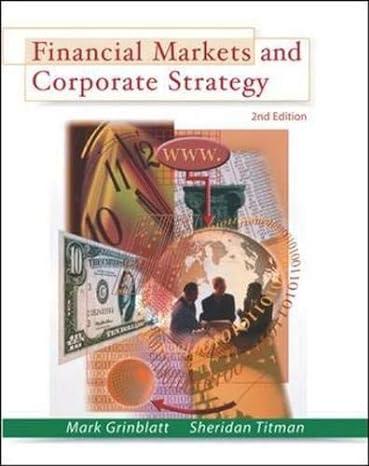Question
.Project A has an internal rate of return of 10%. Project B costs 100 this year and will generate a cash flow of 105 next
.Project A has an internal rate of return of 10%. Project B costs 100 this year and will generate a cash flow of 105 next year. The two projects are not mutually exclusive.
AThe company should only undertake project A
BIf the appropriate discount rate is below 10%, the company should invest in both projects
CIf the appropriate discount rate is above 5% the company should invest in both projects
DIf the appropriate discount rate is above 5%, the company should not undertake project B
2. Stock A has beta equal to 2 while stock B has beta equal to 4. An equally weighted portfolio of the two stocks has an expected return of 10%. This is consistent with
AA risk premium of 3% and a risk free rate of 3%
BA risk premium of 4% and a risk free rate of 1%
CA risk premium of 3% and a risk free rate of 0
DA risk premium of 3% and a risk free rate of 1%
3.In the moral hazard model seen in Lecture 1, consider the effects of an increase both in the private benefit from shirking (B) and in the amount of cash initially available to the entrepreneur (A)
A. Both effects increase the chances that the project will be funded
BBoth effects increase the chances that the project will not be funded
C. An increase in A will make the entrepreneur demand a larger stake in the project, thus reducing pledgeable income. An increase in B has similar effects.
D. An increase in B reduces pledgeable income, while an increase in A allows the entrepreneur to offer a higher return to investors while credibly committing not to shirk.
4. According to the Pecking Order theory of capital structure
A. The value of the company does not depend on capital structure
BFirms generating large income before tax should take advantage of the debt tax shield and operate at high debt levels
C. Firms tend to rely on internally generated funds (retained earnings and depreciation) to finance investment and tap financial markets only if they lack sufficient funds to meet their investment needs
DFirms prefer equity to debt
Alice wants to buy a security from Bob. To Alice, the security is worth x>0, in state G and 0 in state B. To Bob, the security is worth z>0 in state G and 0 in state B, with z A. Alice is always better off when she is informed BBob is always better off when Alice is informed. C. If Alice is uninformed, trade never occurs DIf Alice is informed, trade occurs only if x/2>z Assume that all investors face an income tax of 40%, while capital gains are taxed at 20%. Then, A. The shares of firms doing regular stock repurchases trade at a discount relative to dividend paying firms BThe shares of dividend paying firms should trade at a discount relative to firms doing regular stock repurchases CFirms should never undertake stock repurchases D. Firms should avoid retaining earnings
Step by Step Solution
There are 3 Steps involved in it
Step: 1

Get Instant Access to Expert-Tailored Solutions
See step-by-step solutions with expert insights and AI powered tools for academic success
Step: 2

Step: 3

Ace Your Homework with AI
Get the answers you need in no time with our AI-driven, step-by-step assistance
Get Started


